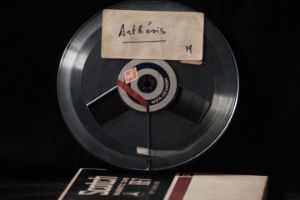Concert & binaural audio livestream | Éliane Radigue
Éliane Radigue: The Electronic Works 17
Chry-ptus (1971)

“Éliane Radigue – Échos”. A film by Éleonore Huisse and François Bonnet, F 2021, film still © Éleonore Huisse, François Bonnet
With the discovery of the modular synthesizer, Éliane Radigue’s methods of composition changed. Moving away from asynchronous tape loops, her electronic works now barely contain perceptible transitions from one sound world to another – as in “Chry-ptus” (1971) and “Arthesis” (1973).
To celebrate the French music pioneer Éliane Radigue’s 90th birthday, MaerzMusik presents her entire electronic music oeuvre for the first time live. A series of seventeen concerts performed under the sound direction of François Bonnet, aka Kassel Jaeger, spreads across the entire festival. Set in the unique acousmatic environment of the Zeiss-Großplanetarium, this homage attempts to give full access to the enchanting depth of Radigue’s music for loudspeakers created between 1970 and 2000.
“Éliane Radigue was born on January 24th, 1932 in Paris, where she still lives and works today. From her Parisian childhood she will keep the memory of a secret initiation into music, mediated by a prudent piano teacher. Then she will continue with the harp, with singing and composition. But it is through the contact with ‘musique concrète‘, alongside Pierre Schaeffer and later Pierre Henry, that Radigue’s music will find its genuine path.
Over more than 50 years there will be three distinct periods, each of them marking a rupture while evoking in its own way an inspired exploration of thresholds, of spaces opening up in intervals, and of a dialogue between listening experience and inner experience, personal history and sensible memory. The first period (1968–1971) is that of work on feedbacks and re-injections, an embryonic phase already signalling extreme preciseness as well as work on thresholds and threatened equilibriums.The second period t hat of maturity, and spanning thirty years (1971–2001), is characterised by a fruitful production of electronic compositions, indelibly linking her music to the unique beats of the ARP 2500 synthesizer. This period also initiates the elaboration of long forms with subtle variations that blossom and resonate between the story carried by the music and the test of time necessary for its unfolding. The third period, still ongoing, is that of her acoustic works created in close collaboration with musician-accomplices coming from all horizons, bringing an additional relational dimension to a music, which until then had been constructed solitarily. Throughout her life, Éliane Radigue has developed a candid, demanding and inspiring body of work which today influences a whole new generation of musicians.” (François Bonnet)
“Chryp-tus consists of two tapes played simultaneously, synchronously or asynchronously (up to one minute out of sync for each tape). The desynchronisation does not affect the structure of the work, but creates infinite variations, mainly in the interplay of harmonics. Three versions were presented during the creation of this work, including variations in amplitude and/or desynchronisation.” (Éliane Radigue)
Programme
Éliane Radigue
Chry-ptus (1971)
Music for loudspeakers / Buchla Modular System on magnetic tape, 24 min
Produced at the electronic studio of the New York University 1971.
Premiered at the New York Cultural Center on 6 April 1971.
Éliane Radigue
Arthesis (1973)
Music for loudspeakers / Moog Modular System on magnetic tape, 25 min 39 sec
Produced and recorded at the studios at the University of IOWA in 1973.
Premiered on 1 May 1973 at the Theater Vanguard in Los Angeles.
Cast
François J. Bonnet – sound direction